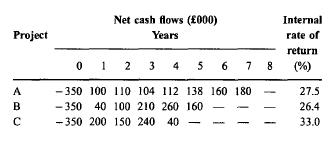Evaluation of mutually exclusive projects using alternative appraisal methods Stadler is an ambitious young executive who has
Question:
Evaluation of mutually exclusive projects using alternative appraisal methods Stadler is an ambitious young executive who has recently been appointed to the position of financial director of Paradis plc, a small listed company. Stadler regards this appointment as a temporary one, enabling him to gain experience before moving to a larger organization. His intention is to leave Paradis plc in three years time, with its share price standing high. As a consequence, he is particularly concerned that the reported profits of Paradis plc should be as high as possible in his third and final year with the company. Paradis plc has recently raised 350 000 from a rights issue, and the directors are considering three ways of using these funds. Three projects (A, B and C) are being considered, each involving the immediate purchase of equipment costing 350 000. One project only can be undertaken, and the equipment for each project will have a useful life equal to that of the project, with no scrap value. Stadler favours project C because it is expected to show the highest accounting profit in the third year. However, he does not wish to reveal his real reasons for favouring project C, and so, in his report to the chairman, he recommends project C because it shows the highest internal rate of return. The following summary is taken from his report:

The chairman of the company is accustomed to projects being appraised in terms of payback and accounting rate of return, and he is consequently suspicious of the use of internal rate of return as a method of project selection. Accordingly, the chair- man has asked for an independent report on the choice of project. The company's cost of capital is 20% and a policy of straight-line depreciation is used to write off the cost of equipment in the financial statements.
Requirements:
(a) Calculate the payback period for each project. (3 marks)
(b) Calculate the accounting rate of return for each project. (5 marks)
(c) Prepare a report for the chairman with supporting calculations indicating which project should be preferred by the ordinary shareholders of Paradis plc. (12 marks)
(d) Discuss the assumptions about the reactions of the stock market that are implicit in Stadler's choice of project C. (5 marks)
Step by Step Answer:






